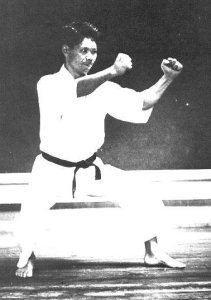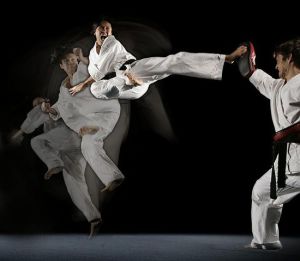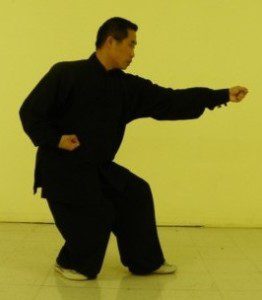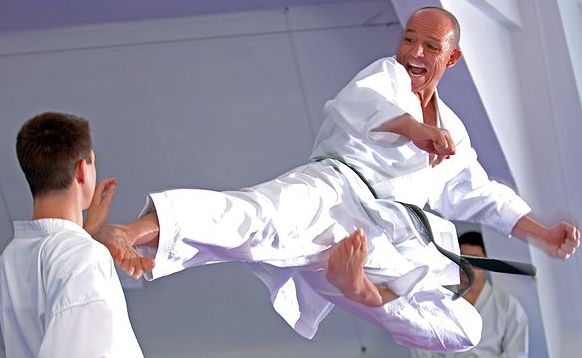Speed up your low stance in Traditional Martial Arts

 Many traditional martial arts are really fascinating with those gentle and strong coordinated movements.
Many traditional martial arts are really fascinating with those gentle and strong coordinated movements.
Katas or form training are the basics for the students to proper learn stances, movements, timing, breathing, concentration of particular moves.
Most likely they are a reproduction of a fight with imaginary opponents in different situations and positions.
Shotokan Karate for example is one of those martial arts where Katas are a big part of the training and you must perform them perfectly in order to pass any exam to rank up during your studies.
Kata training is something that younger generations are not always are interested to learn.
Youngsters are bored like hell of these dancing moves apparently without any real life situation meaning.
When i first got into Shotokan Karate in my teenage years, I just wanted to train sparring as it was much more fun!
But of course I had to follow the Sensei program and learn properly the Katas with the same vigor as Kumite (sparring sessions).
A that time I was told that I would appreciate Katas when I grow older, and I have only to confirm.
Long time waiting the Sensei explaining the new moves and the absence of dynamic movements in my training made me concentrate in what i was actually doing: Keep a low cool perfect traditional stance for long time.
It was kind of hurting being in that sort of constant squat but it became a kind of achievement that I was proud of.
 After few months of low static stance training during Katas, I had to prepare for a Kumite competition and I noted that i wasn’t fast as i tought i was.
After few months of low static stance training during Katas, I had to prepare for a Kumite competition and I noted that i wasn’t fast as i tought i was.
When i wanted to step forward to attack my opponent i felt like i was “glued” in my lower body
For how much i was trying to be fast on my steps, i couldn’t get any improvement.
And most important, my beloved fast high kicks where going in slow motion making my opponent dodging my attacks like Spiderman.
That was awkward…
So what happened to my speed steps? Where did my fast moves go?
The previous period of training for Katas had been a hard and perfect workout for my legs but only at Isometric level!
Isometric training is a kind of work out to harden muscles for a specific position without using the whole range of motion. It’s basically when you apply force to an immovable object and you contract all muscle fibers. To give you an example, “Planking” is an isometric exercise to harden your core muscles (in that case is good to have a “muscle armor” to protect you while in a fight).
 Training low stances for long periods will train your muscles to stay perfect and strong in position but your speed will disappear as your legs just are not trained to give speed and power throughout the full range of motion needed. No speed and no explosiveness are improved in isometric training.
Training low stances for long periods will train your muscles to stay perfect and strong in position but your speed will disappear as your legs just are not trained to give speed and power throughout the full range of motion needed. No speed and no explosiveness are improved in isometric training.
There are times in the dojo when the Sensei will engage you in long form repetitions and katas leaving little time for sparring.
I’m not judging any teaching method here, I fully respect the dojo and what is coming with it. However you should also consider to complete your body workout with what you feel may be missing for a total training.
While low stances and form training will improve your slow twitch leg muscles, you can keep and improve your fast twitch muscles with few exercises to do any time.
Here is a list of useful exercises you can use in order to improve your lower body and achieve great speed, reflex, power and explosiveness to give your best during sparring sessions.
Long jump burpees
This is the exercise to provide the explosiveness to your legs to get power steps forward when sparring.
1. With your feet together place your hands on the ground.
2. Jump your feet into a plank position (like a push up)
3. Jump your feet back in (knees near your body)
4. Jump forward as far as you can.
5. Repeat.
Make sure you keep a good posture and place your feet all the way in before you jump.
Backward Jump Burpees
This exercise is perfect for improving performance in marital arts. It strengthens the body and develops explosive power in the legs.
1. With your feet together place your hands on the ground.
2. Jump your feet into a plank position (like a push up)
3. Jump your feet back in (knees near your body)
4. Jump backward as far as you can.
5. Repeat.
Make sure you keep a good posture and place your feet all the way in before you jump.
Don’t jump to far and avoid falling down.
Jumping Lunges Moving
Lunges in general are quite hard to perform. make sure you have plenty of rest between your workouts when you engage in these exercises (at least a couple of days).
1. Stand with your feet at shoulder width, holding your hands in front of you as in relaxed guard position.
2. Step forward one foot about 16 to 20 inches and low your hips while descending.
3. Jump forward and immediately switch foot position.
4. On landing, absorb into a lunge by bending your knees and lowering your hips again.
5. Jump forward and immediately switch foot position.
6. Keep repeating for the specified times.
If you are in karate training you can use Zenkutsu Dachi stance. Keep your front foot and knee pointing forward.
Matrix Lunges
These are lunges in multi axial directions and will create an awesome full body exercise.
Even if this exercise can be performed slowly for emphasis on muscular development we prefer to use if faster to develop the neuromuscular system and speed up our legs.
1. Stand with your feet at shoulder width, holding your hands in front of you as in relaxed guard position.
2. Step one foot out to the side about 16 to 20 inches and low your hips while descending.
3. Drop your shoulders forward, touch the ground with your hands.
4. Push back to the start position while thrusting your hands overhead.
5. Repeat with the opposite leg.
6. Step one foot backward about 16 to 20 inches and low your hips while descending and turning your position backward.
7. Drop your shoulders forward, touch the ground with your hands.
8. Push back to the start position while thrusting your hands overhead.
9. Repeat with the opposite leg.
10. Step one foot forward about 16 to 20 inches and low your hips while descending.
11. Drop your shoulders forward, touch the ground with your hands.
12. Push back to the start position while thrusting your hands overhead.
13. Repeat with the opposite leg.
14. Repeat for a specified number of time.
Allow the shoulders to drop and the back to round forward while reaching down.
Zigzag Run
The zigzag run will develop hip flexibility, body balance, and increase body awareness.
1. Run in a zigzag pattern, using long steps each side.
2. Swing your elbows from side-to-side.
3. Lean the body forward in the direction of motion.
Be relaxed and remember to swing your elbows. Make your feet bounce and not slide on the floor.
Line Drill
Line drill develops speed, agility and quickness. It’s a great dynamic exercise to increase body control and awareness.
You could use Line Drill together with the previous Zigzag Run for a different workout.
1. Set two points at a certain distance from each other.
2. Sprint from one point to the other as fast as you can.
3. When you reach the second point, lower your center of gravity and quickly change direction to sprint back to the first point.
4. Make sure you turn to both the left and right for the this drill.
Add always 10-15 minutes of Jumping Rope to train your calves and improve your cardiovascular resistance, you will have a complete body workout assimilated in your Martial Arts training.
Feel free to leave a comment here below and add some of your experiences and workout results.

You can download a FREE PDF with the workouts listed in this article. Just click the PDF logo here:
Photo credits: “Gigo funakoshi” by disciples of sensei Yoshitaka Funakoshi – property of the uploader. Licensed under Public domain via Wikimedia Commons. “Yang Hai demonstrating Xing Yi Beng Quan, August 2013” by Master Yang Hai of Montreal, Canada. – Master Yang Hai personally emailed me the picture, which he had photographed himself, for me to upload to Wikipedia. Licensed under CC BY-SA 3.0 via Wikimedia Commons. “Steven Ho Martial Arts Kick” by Nick P. Original uploader was Nt2bd at en.wikipedia – Transferred from en.wikipedia(Original text : Own work by uploader). Licensed under CC BY-SA 3.0 via Wikimedia Commons. „YokoTobi Dietl“ von Toni Dietl. Original uploader was Claus Michelfelder at de.wikipedia – Claus Michelfelder. Lizenziert unter CC-BY-SA-3.0-de über Wikimedia Commons. Tags: discipline, exercise, form, karate, kata, Kung Fu, Martial Arts, speed, stance, traditional, training

